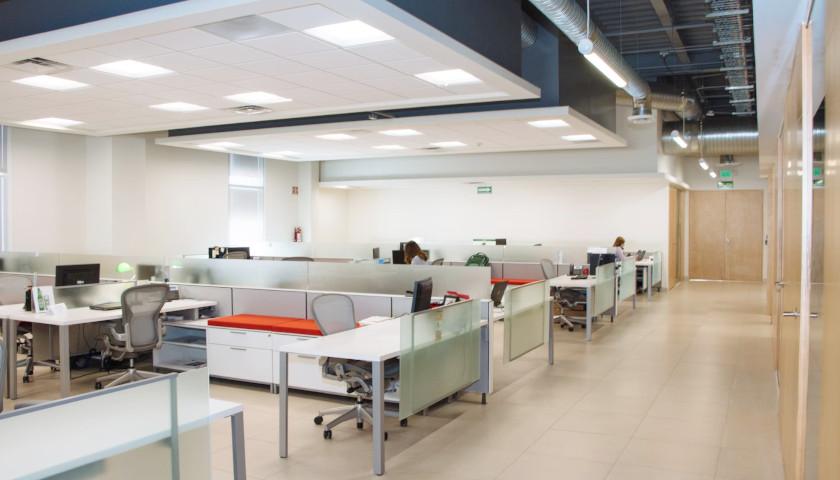by Susan Crabtree
More than two years after the Biden administration called on all federal agencies to create plans to bring employees who teleworked during the COVID pandemic back to the office, the vast majority of Washington, D.C.’s federal buildings are still sprawling expanses of empty, echoing hallways and offices.
In fact, 17 of 24 federal agencies use an estimated 25% or less of their headquarters’ office capacity, according to an updated survey by the General Accounting Office, a government agency that provides auditing and investigative services for Congress.
The survey showed that all federal buildings except the Treasury were operating at or below 31% office occupancy, with some far below that level, during the period surveyed. The Treasury Department has done better than most in seeing its employees return to work. Forty percent of the Treasury Department was back to work when the GAO survey was conducted.
The Social Security Administration and the Housing and Urban Development offices were both at 7% occupancy; the Small Business Administration was at 9%; the Office of Personnel Management notched in at 12%; and the Transportation Department was at 14% occupancy. The General Services Administration, which manages all federal buildings, was operating at 11%, as was the Department of Agriculture.
The U.S. Agency for International Development is located in the expansive Ronald Reagan Building, the second largest government building after the Pentagon, with 3.1 million square feet of office space on 11 acres. USAID’s occupancy was at 23%. The Department of Homeland Security, which under Secretary Alejandro Mayorkas’ leadership has come under fire from Republicans for failing to secure the southern border, was at 31% occupancy during the periods the GAO surveyed.
Although many private companies, which must answer to shareholders, have offloaded their pricey office space as many employees have shifted to telework, the U.S. government continues to pay a hefty price tag for office space while allowing liberal remote work. Federal agencies spend roughly $2 billion a year to operate and maintain federal office buildings and an additional $5 billion to lease office buildings, according to the GAO.
The government auditing agency recently released its updated occupancy findings to Iowa Republican Sen. Joni Ernst. The report sampled federal agencies’ use of office space across a three-week period earlier this year.
“This Christmas season, I’m calling on Biden’s bureaucrats to deck the agency halls with federal workers or sell off unused space,” Ernst told RealClearPolitics.
“Four years have passed since COVID temporarily closed federal buildings, but bureaucrats are still failing to show up for work,” she said in a statement.
Ernst called out a “naughty list of no-shows,” which have taxpayers “on the hook” for paying for their expensive office space.
“No wonder [Transportation Secretary] Pete Buttigieg can’t address delays for Americans going home for the holidays if he can’t even get his employees to show up to work,” she said. “And while DHS headquarters remains nearly empty, illegal immigrants are filling up sanctuary cities. Ironically, instead of getting the homeless off the streets, no one is even home at HUD.”
The COVID pandemic’s liberal telework policies have exacerbated low occupancy rates, though federal agencies have vastly underutilized their office space since the early 2000s. Based on its calculations for one of the federal headquarters buildings, the GAO estimated that only 67% of building capacity would be used even if all assigned staff entered the building on a single day.
“As the country emerges from the pandemic and agencies continue to offer telework as an option, the federal government has a unique opportunity to reconsider how much and what type of office space it needs,” the GAO concluded in a July report.
Although an official breakdown by agency of the number of workers working remotely at least part-time does not exist, far more government workers have been working remotely since the COVID pandemic. The liberal COVID telework policies have become a catalyst for the need to modernize and downsize the federal real estate portfolio, said Tom Schatz, president of Citizens Against Government Waste, a taxpayer watchdog group.
“Federal real property management has been on GAO’s high-risk list since 2003 because the government has had more space than it needs,” he said in an interview. “It’s a matter of establishing what the government needs and where they need to have these headquarters. It really could not be a simpler decision.”
Schatz and other like-minded watchdogs support a campaign to move some federal office agencies out of D.C. and closer to the people most impacted by the agencies’ policies. Ernst, along with Ohio Republican Rep. Bill Johnson, sponsored a bill in 2022 that would distribute agency headquarters throughout the country and would, according to Ernst and Johnson, provide the added benefit of bringing stable jobs to other parts of the United States.
Schatz said the Biden administration hasn’t signaled whether it would support such a move but is pressing agencies to bring their employees back to work.
Earlier this fall, facing large numbers of federal workers who were still not coming into the office, the White House privately pushed Cabinet secretaries to bring their employees back, Axios reported. Only about half of Cabinet agencies had achieved the White House’s goals of returning to office work by January. White House Chief of Staff Jeff Zients has made returning to the office a priority for both the White House and the broader executive branch and sent a Cabinet-wide memo over the summer urging an end to telework.
“We are running to in-person work because it is critical to the well-being of our teams and will enable us to deliver better results for the American people,” Zients wrote.
During an early October Senate hearing, the billions of dollars spent for empty federal office space came under fire. Sen. Shelley Moore Capito, a West Virginia Republican, voiced deep concerns over wasted resources used to heat, cool, and maintain the underutilized buildings.
“Each year, it costs billions of taxpayer dollars to operate and maintain these federal buildings, regardless of their utilization,” she said. “This is simply unacceptable.”
Congress also has passed laws, including the Inflation Reduction Act, giving the General Services Administration, which runs the federal buildings, funds to make buildings more energy efficient and resilient to climate change and to promote the use of low-carbon materials.
Half of the GSA-managed leases are set to expire by 2027, which Delaware Democratic Sen. Tom Carper said provides an opportunity to downsize the building space. Carper added that DHS is already working to reduce its office footprint in Washington, D.C., by more than 1.2 million square feet. That effort alone would save taxpayers an estimated $1.3 billion over the next 30 years, according to the GSA.
– – –
Susan Crabtree is RealClearPolitics’ national political correspondent.





